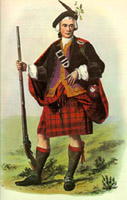Cameron is a place name in the ancient kingdom of Fife meaning “crooked hill” from the old Gàidhlig words cam brun. It gave its name to a knightly family who were prominent in the counties around the Tay estuary in the Middle Ages. [1]
Famous among the Highlanders as Domhnull dubh Mac Ailen, Black Donald, son of Allan, and from whom the chief of the clan takes his patronymic of Mac Dhomh’nuill Duibh.
In 1214, Adam de kamerun was witness to a charter to the monks of Cupar. (2)
In 1219 Hugh Cambrun was the sheriff of Forfar and in 1233 Johannes Cambron was a charter witness in Moray. In 1360 the Cameron clan received the first official grant of lands of Lochaber and they were later granted Lochiel and Locharkaig by Righ Innse Gall (Lord of the Isles).
The origins of the spellings and derivations of names have been confused with nationality and religion. M’c Mac M’k Mac Mhic all mean the same thing, son of, Nic N’c N’K Nighean is the female equivalent for daughter of. The differing spellings are down to the scribe and its phoenetic equivalent, literacy and the anglicisation of Gaidhlig names. Your patronymic would have ‘ic between each generation. My patronymic within MacKinnon who married into Cameron’s of Easter Moy is Caomhin ‘ic Barrie ‘ic Farquhar ‘ic Farquhar ‘ic Donald ‘ic Archibald ‘ic Duncan. Highland culture would expect you to know at least six generations of your ancestors and the sennachie had the responsibility of committing genealogies to memory.

Ailean nan Creach (Allan of the Forays) 1st Captain of Clan Cameron!
Allan went among his neighbours demanding they adopt the Cameron name. Allan started this campaign by inviting himself to lunch in a house by Loch Oich owned by Donald Mor MacWilkane. Despite the honour of the visit by the ferocious warrior and cattle raider Ailean nan Creach Donald refused to change his name.
After a fine meal Allan was shown out into the sunlight by his host.
“Allan drew back and coming behind MacWilkane he asked him in Gàidhlig
“De ‘n uair a tha e”
Donald never suspecting treachery put his right hand to shade his eyes as he sought to tell the time from the sun, but before he was to say a word the wily Allan had severed his head with one sweep of the broadsword…
“Mu ‘n robh am focal air bàrr a theangaidh, bha a cheann air bàrr a bhròige”
(Before the word was on the tip of his tongue his head was on the top of his shoe).
The Clan Structure!
The clan can be summarised as something similar to Maslow’s hierarchy with the Chief at the Apex. Daoin Uaisle are his direct blood relatives.
Duthaich Dane are the common folk made up of two smaller nomenclatures.
Duthaich Fine or true people were clan that believed themselves to be related by blood to the Chief.
Sencliath were the people of the soil those that had inhabited the lands before land was granted or taken by a more powerful Clan.
The Mormaer was the Chief.
The Tanist was next in succession and this was sorted usually during the life of the Chief.
The Toisich was the oldest cadet among the Ceanntaighean or the head of the houses.
Daoin Uaisle were the clan’s gentry, all cadets of the Chiefs House.
The Chiefs Staff:
The Henchman.
The Bard or Poet.
The Bladair or Spokesman.
The Gillemor (bearer of the broadsword)
The Gillecasafliuch (Carried chieftain over fords)
The Gillecoinnhideachd who would lead the chief home safely.
The Gillet-ruisalach who carried baggage.
The Piper who was a gentleman!
Piper’s Gillie who carried the bagpipes.[3]
Aonaibh Ri Chéile (Let Us Unite).[4]
[1] The Highland clans Moncreiffe of that ilk and David Hicks.
[2]“History of the Camerons, with genealogies of the principal families of the name by Alexander MacKenzie 1838-1898
[3] Memoirs of clan fingon with family tree 1899 page 3 (4) http://www.clan-cameron.org/cam-ref.html
Caomhìn Mac Fhionghuin (Kevin MacKinnon)
